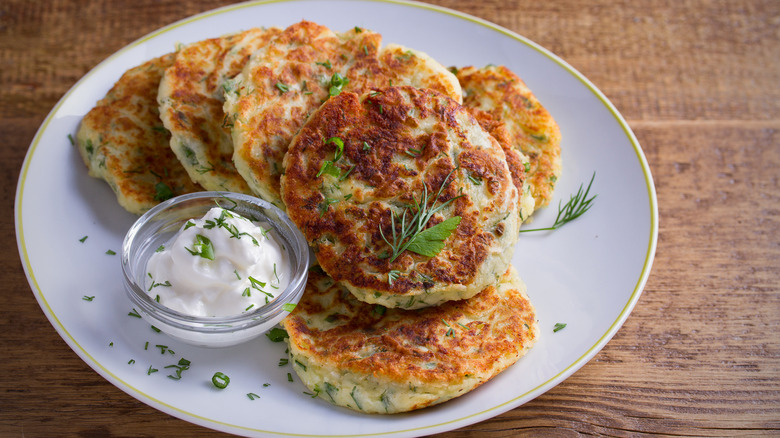How Latkes Became An Integral Part Of Hanukkah Traditions
One of the most beloved Hanukkah dishes, the latke is a comfort food heavy with symbolism. The modern incarnation of latkes features a mix of shredded potatoes and seasoning fried in oil and served with either sour cream or applesauce. The food is readily associated with the holy day because of Hanukkah's miracle of the oil where the menorah at the Temple of Jerusalem burned for eight days during the Maccabean Revolt. Though it may seem like this fried fritter has always been the latke of choice, earlier — and decidedly cheesier — variations were the original latke made during Hanukkah.
This kind of latke resembles more of a diminutive Russian pancake, the blini, than a fritter. Indeed, it can trace its origins to a kind of salty, ricotta pancake made by an Italian Rabbi in the 13th century. Later, Jews fleeing from Spanish-controlled Sicily during the Inquisition resettled in Northern Italy and brought their recipe for "cassola," aka fried cheese pancakes, with them. Naturally, the oil-frying aspect honored the traditional Hanukkah miracle, but the cheese (and dairy in general) worked as a nod to another Jewish story: Yehudit and Holofernes. In this gory tale, the lovely widow Yehudit plied the Assyrian general Holofernes with wine and cheese before beheading him, simultaneously saving her sieged city and allowing the Jewish army to beat the leaderless Assyrians in a surprise attack. Since this story is closely intertwined with the Maccabean Revolt, cheese became another ingredient to weave into culinary Hanukkah traditions.
A tale of oil and cheese
So when did the classic Italian cheese pancakes become the potato-packed latkes we know today? For the potato latke, we can thank the Ashkenazi Jews of Eastern Europe. Originally, the Ashkenazi people enjoyed a variation of latkes made with buckwheat and rye — while the Central and Western European Jews ate kaese (cheese) latkes. By the 18th century, potatoes were brought to Eastern Europe from South America and became a staple crop after a bout of famine. Inexpensive and hearty, potatoes became an important element of Ashkenazi cooking, and soon found their way into the delicious latkes.
There was another reason that the cheese had to be dropped. Ashkenazi cooks often used schmaltz (chicken fat) to fry their food, a readily available commodity in their villages. In Kosher law, the mixing of dairy and meat is forbidden, so the potato stepped in for the cheese to keep the food Kosher. While the cheese was nixed, the one constant throughout the history of latkes is its reliance on frying and oil. All other adaptations were made with an eye toward economy, availability, and, of course, flavor.


